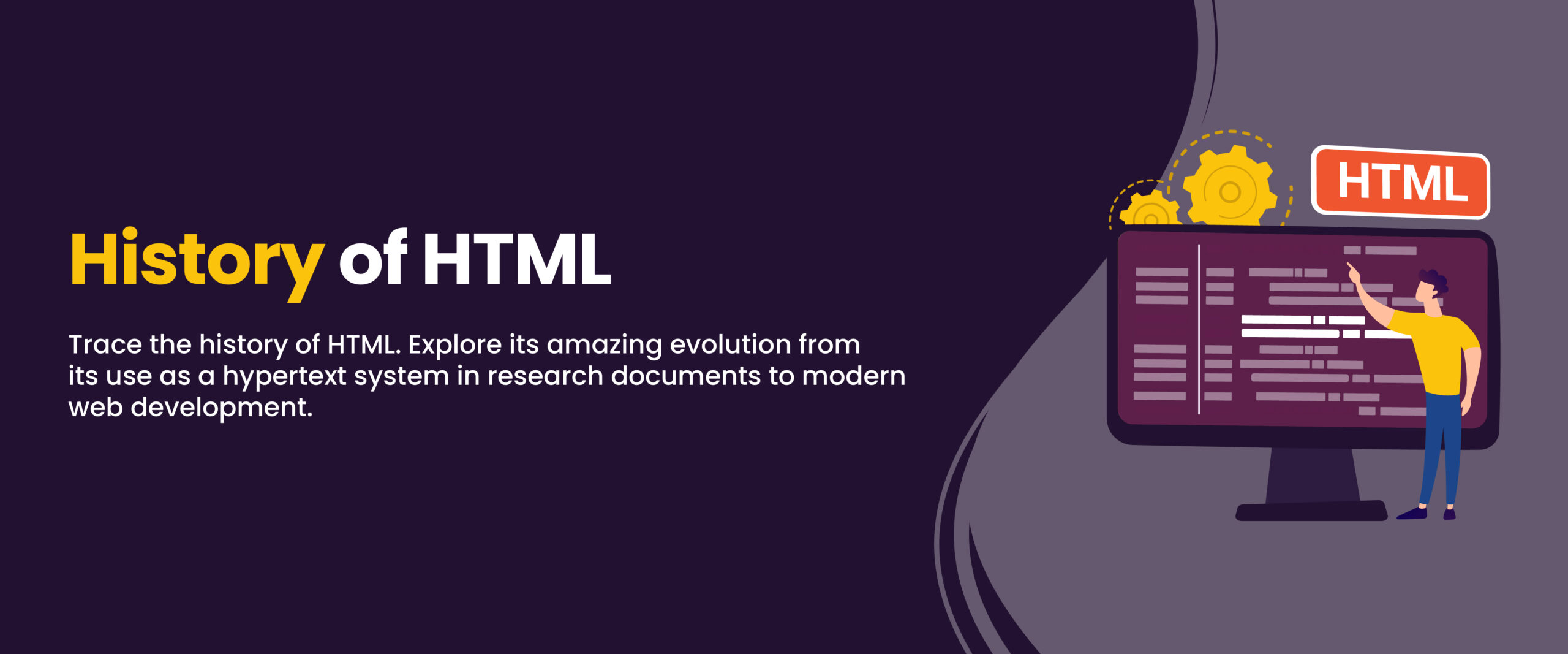History of HTML: A Journey Through the History of the Web’s Language
The history of HTML can be traced back to Sir Tim Berners Lee’s concept of creating an efficient markup language to exchange data. It has undergone significant improvements since then and with the introduction of HTML5, the spheres of web development have broadened further. Today, over 1.8 billion sites serve as testimony to how HTML has shaped the digital landscape. In this blog, we will provide a brief overview of the evolution of HTML, covering the rise of HTML 3.2, CSS, 4.01, XHTML, and eventually HTML5.
The Birth of HTML
The history of HTML tells us that it came into existence with just eighteen tags. HTML 1.0 pioneered the principles of organized information and hypertext on the web. It also had very few style and interactive options.
- HTML 1.0 was the first standardized version of HTML and was published as an Internet Draft in 1993. It laid the foundation for structuring content on the World Wide Web.
- HTML 1.0 provided a simple structure for creating web documents, utilizing tags enclosed in angle brackets (< >) to define elements and their relationships.
- HTML 1.0 primarily focused on structuring content, with only basic formatting options like headings, paragraphs, and lists.
- Hyperlinks were a fundamental feature of HTML 1.0, allowing users to navigate between different documents or sections of the same document.
Transform your skills and secure a job upon completion of our full-stack developer course with placement guarantee.
Evolution of HTML
The creation of HTML 1.0 laid the essential foundation, but the later versions of HTML led to advancement in the field of web development. HTML 2.0 revolutionized web designs with table and image embedding, while HTML 3.2 had more text elements to enhance the design structure.
RSS feeds and more dynamic content came with HTML 4.01 and XHTML focused on the standardization of code for enhanced multi-device support. Let’s look at each of these developments in detail.
HTML 2.0 Standardization and Advancements
HTML 2.0 marked a significant milestone in the evolution of web development. This version introduced essential elements for revolutionizing web designs and paving the way for future advancements in web technologies.
- It established HTML as the standard language for structuring web content.
- New elements like tables and image embedding were introduced, enhancing web design possibilities.
- Tables allowed developers to create more organized and complex layouts.
- Image embedding improves visual experiences on web pages.
- Basic form capabilities were introduced, enabling interactive elements like input fields and buttons.
- HTML 2.0 set the stage for further innovations in web technologies.
The Rise of HTML 3.2 and Cascading Style Sheets (CSS)
The development of HTML 3.2 and Cascading Style Sheets (CSS) added new dimensions, allowing for more visually appealing and sophisticated websites. These advancements laid the foundation for the modern web development landscape we see today.
- HTML 3.2 brought an essential turning point in web design, adding several features that made websites visually appealing.
- HTML 3.2 introduced elements that allowed designers to format text, regulate background images, and control textual color, enabling more visually appealing websites.
- Despite these improvements, there were inherent constraints as structure and presentation elements were closely intertwined, limiting the range of available designs.
- The evolution of worldwide internet networks and the advent of Cascading Style Sheets (CSS) marked a significant turning point for web developers.
- Concurrently with the evolution of worldwide internet networks, advancements in industry-leading software, such as Cascading Style Sheets (CSS) emerged.
- CSS was presented by the highly respected global organization, the World Wide Web Consortium (W3C).
- Unlike HTML 3.2, which focuses on structural aspects, CSS pioneered the separation of appearance-based features, empowering developers to have greater control over the visual elements in the website design process.
- By decoupling structure and presentation, CSS allowed more flexibility, creativity, and consistency in designing websites.
- Web developers could now define styles in a central CSS file and apply them across multiple web pages, making it easier to maintain and update the design of entire websites.
HTML 4.01 and the Introduction of Extensibility
The emergence of 4.01 facilitated the development of RSS feeds and paved the way for the seamless integration of dynamic content from various sources. It has a significant impact on the HTML version history and remains a testament to the continuous drive for extensibility and innovation within the web development community.
- Valuable features, including dynamic content support, scripting capabilities, and multimedia embedding functions.
- The emphasis on structural choices over stylistic ones led to the recommended implementation of CSS, separating content from presentation.
- The introduction of Extensible Markup Language (XML) marked a significant progression in the history of HTML.
- XML technology provided professionals with greater flexibility in creating markup languages.
- It allowed the establishment of custom tags and structures tailored to specific needs.
- These advantages influenced future developments within HTML and paved the way for pioneering technologies in the web industry.
You can learn more about HTML from an online web development course.
XHTML and the Move Towards Strictness
XHTML’s strictness improved how websites work and look on different devices. It encouraged developers to write cleaner code. While it became less popular later on, its influence on better coding practices remains essential for modern web development.
- XHTML (Extensible Hypertext Markup Language) evolved from HTML, combining HTML’s syntax with XML’s strictness and clarity principles.
- It was initially released in 2018 and received an upgrade in 2001 due to high adoption rates in the preceding year.
- The move towards strictness aimed to improve interoperability between web browsers and devices, ensuring a consistent user experience.
- Web developers were encouraged to write cleaner and more standardized code with XHTML.
- Advanced technologies like XHTML Modularization and XHTML Family Markup Languages were implemented.
- Some existing websites faced challenges in becoming compliant with XHTML.
- Despite initial popularity, HTML5 with its relaxed syntax gained traction, affecting XHTML’s adoption.
- The principles from XHTML’s emphasis on strictness continue to influence modern web standards and coding practices.
HTML5: A New Era of Web Development
HTML5 revolutionized web development by providing a more versatile and efficient platform for building modern web applications and responsive websites.
Key Features and Advancements
- In 2008, W3C began work on HTML5’s key features and advancements, representing a significant update for the language.
- HTML5 brought advanced backend capabilities and various features for website development, leading to a better user experience.
- The introduction of semantic elements like <header>, <nav>, <article>, and <footer>, improved website organization and accessibility.
- HTML5’s standout feature was support for audio and video elements, replacing the need for third-party plugins like Flash and offering captivating multimedia experiences on the web.
- Another crucial addition was the <canvas> element, enabling developers to create dynamic graphics and animations directly within the browser.
- HTML5 empowered developers with straightforward technology to build interactive websites, opening up new possibilities in web development.
To learn more about HTML5 and how it differs from HTML, check out this blog on HTML Vs. HTML5.
The Future of HTML: HTML6 & Beyond
As technology continues to evolve, the development of HTML6 aims to revolutionize the web browsing experience with cutting-edge features and improved performance.
1. Proposed Features for HTML6
HTML6 suggests improved accessibility attributes, compatibility with mobile gadgets, and integration with emerging technologies, such as synchronization with Virtual Reality (VR) and Augmented Reality (AR) support. It also has enhanced multimedia capabilities and streamlined data handling.
2. Compatibility and Backward Compatibility
To ensure a smooth transition from HTML5 to HTML6 for the existing websites, it is essential to maintain backward compatibility for older websites. This allows websites to remain fully functional.
3. Performance and Efficiency
In the future, HTML6 and subsequent versions will prioritize performance and efficiency by implementing optimizations for faster loading times, reduced data usage, and enhanced caching mechanisms to improve website performance.
4. Security Enhancements
HTML6 will prioritize security enhancements by incorporating best practices for secure coding and data protection. These measures aim to provide a safer and more resilient browsing experience for users across various digital platforms.
5. Modular Architecture
HTML6 will adopt a modular architecture, organizing the language into smaller modules to facilitate easier development and maintenance while allowing seamless integration of new features without disrupting the entire language.
6. Collaborative Development
HTML6 and beyond will actively involve the web development community, encouraging feedback and contributions. It will adopt an open-source approach to ensure a more inclusive and community-driven development process.
Conclusion
HTML began as a modest tool for linking documents, laying the foundation for the history of HTML and its subsequent evolution into a dynamic and adaptable language that supports the World Wide Web at its core. Its progression from rudimentary tags to fully equipped HTML5 embodies how web development continuously enhances itself.
Did you find this blog informative? Share your thoughts with us in the comments section below. Also, check out this blog on HTML tags.
FAQs
The 5 types of HTML are the five versions of the markup language. They include HTML 1.0, HTML 2.0, HTML 3.2, HTML 4.01, and XHTML. The sixth and the latest version is called HTML5.
HTML is currently maintained by Web Hypertext Application Technology Working Group (WHATWG), a consortium of major browser vendors Microsoft, Apple, Google, and Mozilla.
The father of HTML is Sir Timothy John Berners-Lee, also known as Tim Berners-Lee. He is an English computer scientist who wrote the first version of HTML in 1993.
The five uses of HTML include internet navigation, the creation of responsive designs, webpage development, game development, and the creation of web documents.
HTML was invented at CERN, the European Laboratory for Particle Physics (or Nuclear Research) in Geneva, Switzerland.
The first HTML editor (WYSIWYG) that was launched was WebMagic. However, the first HTML editor to be created was Bravo, though it was not publicly marketed.
The logo for HTML5 was designed by the Ocupop design agency. It was developed with the purpose of representing technologies that constitute an open web platform.






